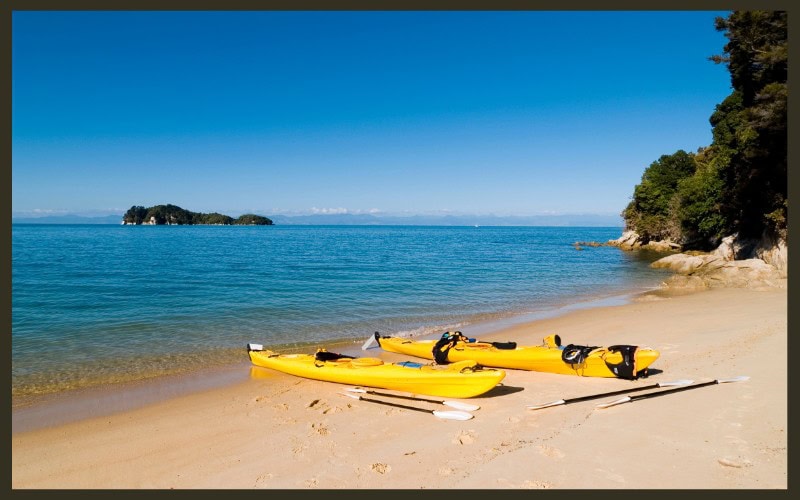Abel Tasman National Park: Best Luxury Adventure
Artsy Traveler contains affiliate links for products and services I personally use and can happily recommend. As an Amazon Associate, I earn from qualifying purchases. Please read the Disclosure for more information. If you make a purchase through these links, at no additional cost to you, Artsy Traveler earns a small commission. Thank you!
If you’re looking for a wonderful way to experience Abel Tasman National Park on New Zealand’s South Island, then I highly recommend taking a multi-day kayaking and hiking trip with Wilsons Abel Tasman. Their tours perfectly blend comfy accommodations and gourmet food with serenity, mild physical challenge, and soul-nourishing beauty.
Abel Tasman National Park is where golden sand meets turquoise sea, and the forest hums with ancient life. The best way to fully enjoy the park is by hiking its quiet trails and kayaking along the shore. You can experience the park independently, but if you’re traveling and don’t have camping gear, consider taking a tour.
I chose a three-day Kayak & Walk Adventure with Wilson’s and experienced a seamless mix of luxury, logistics, and natural wonder. Wilsons Abel Tasman orchestrates every detail so you can simply breathe, paddle, and walk your way through paradise.
In this post, I provide a detailed account of my experience on the Wilsons three-day Kayak & Walk Adventure in Abel Tasman National Park. Note that the company provides many other tour options, from half day hikes to five-day adventures and even custom itineraries.
NOTE: I paid in full for my experience with Wilsons Abel Tasman and receive no income from them. I wrote this post solely to share what I consider to be one of the best Multi-Day tours I’ve taken in fifty years of traveling.
Day 1: Starting the Abel Tasman Multi-Day Trip
The day before the start of the journey, Julia and I stay at Grand Arden Monaco-Nelson (definitely recommended) where two sturdy black carry-on style duffle bags are delivered. That little detail endears me to Wilsons before I even start the tour.
From the moment I open my lovely new bag to when I empty it of salt and sand-crusted clothes at the end of the tour three days later, every detail is cheerfully taken care of.
Promptly at 10:15 am, a bus collects us for the 40-minute ride to Motueka through New Zealand’s breadbasket: rolling fields of apples, hops, and grapes stretching to the horizon.
Our driver shares local lore such as how tobacco once dominated these valleys until it was replaced by healthier, more sustainable and less tax-intensive crops.
At the Wilsons office in Motueka, I put my cash, my phone, and my passport in the company safe and receive my day pack which I load up with a jacket (never once needed), my camera, the company-provided water bottle, my bathing suit and beach towel, a pair of water shoes which will apparently be needed later in the afternoon, and the obligatory bottles of insect repellent and sun screen.
I experience a few moments of terror giving up my phone, but decide that three days with no access to a screen will do me good. Julia does not give her phone up, although the following day she puts it in her back pocket and then sits on a rock.
The screen cracks and she is not amused, but fortunately, the damage is not terminal.
The Boat to the Start of the Track
From Motueka, we drive to Kaiteriteri and board a sleek boat for a one-and-a-half-hour ride up the coastline. What takes one and a half hours by fast boat going up will take three days coming back via track and kayak.
The scenery is pure fantasy:
- Golden crescents curve around turquoise seas
- Forested hills roll into the distance
- Beaches glow like honey under the sun
We sit on the upper deck, faces kissed by the wind. The boat stops at quiet coves to drop off hikers and pick up others. A highlight is passing the famous split apple rock.
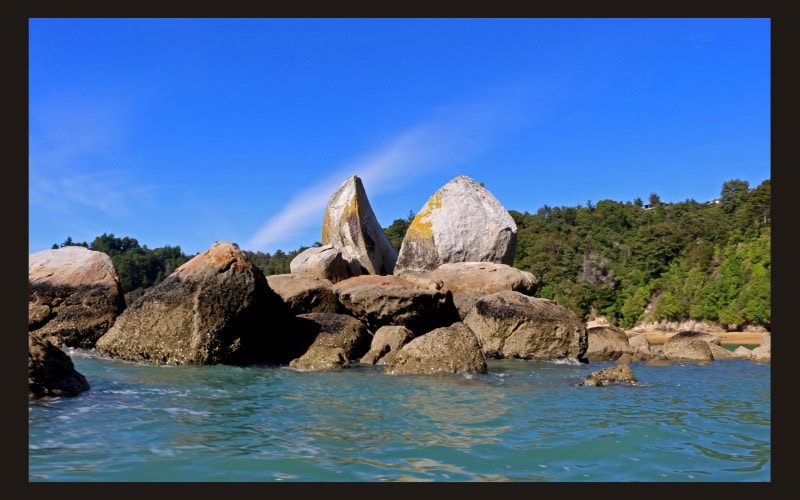
We land at Tōtaranui and get ready for what will be a seven-kilometer walk along a portion of the Abel Tasman track to our first stop—the Meadowbank Homestead where the ancestors of the Wilsons first settled as pioneers back in the 1880’s.
First Steps on the Abel Tasman Track
I eye the rest of our group — couples from England, Belgium, Santa Fe, and Auckland — and silently rank their apparent fitness levels. My desk-bound winter self is nervous.
The first part of the track is an easy stroll past the campground. However, too soon, the three-foot wide, evenly graded, hard-packed track starts to climb. I hate that my breathing turns quickly to gasps. Will I be the lame duck of the group, trailing far behind, praying for quick death?
Fortunately, I manage to keep up with Garrick, our knowledgeable and cheerful guide who, bless his Kiwi heart, stops frequently during the climb to point out flora and fauna and talk about the sobering effects of climate change and the damage wrought by centuries of misuse by humans, particularly during the past two centuries.
I learn that New Zealand’s unique bird life once thrived without predators until the Māori and later the European colonists introduced mammals like rats, stoats, possums, and other furry wee beasties. The result? A 97% drop in native bird populations.
That’s a lot of birds gone forever. The forest we walk through looks primeval but is in fact second growth, just like in my home in British Columbia. Birds are in evidence but there are so many fewer than there once have been.
We pass traps set to protect the remaining birds from marauding mammals. At the summit of this portion of the track, we’re rewarded with a view of a golden arc of beach fading into a vivid turquoise sea.
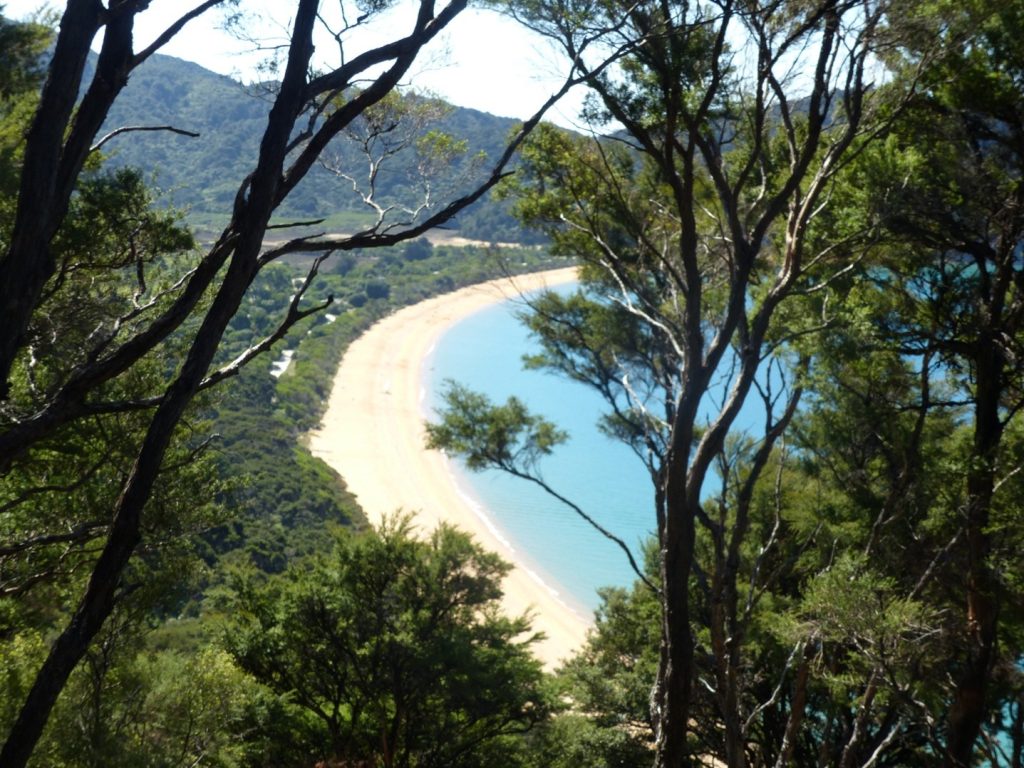
We then head downhill, occasionally glimpsing the ocean but mostly enclosed in forest. The track leads to an empty beach. We walk along it for a fair distance, the sun blazing. I look for wetter sand that doesn’t give as easily, but progress is slow.

Then it’s back up the track for another climb—steeper but not too long. My confidence grows. The track then winds over mostly flat ground enclosed on both sides by lush forest.

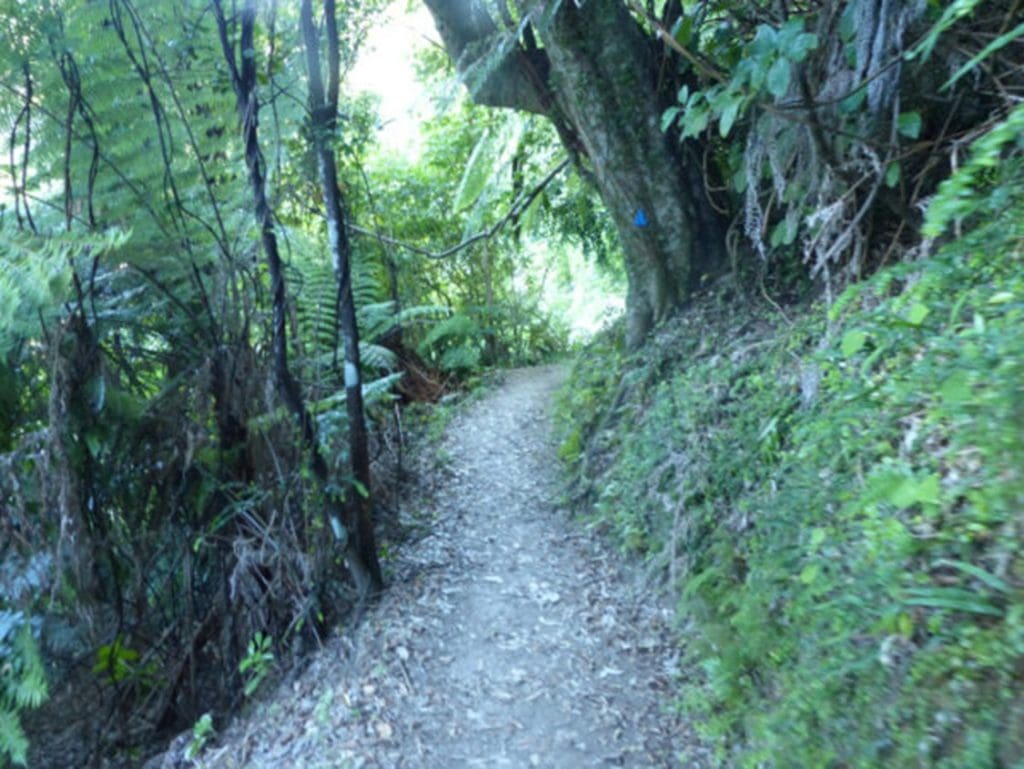
The Great Estuary Crossing
We arrive at a wide estuary, and Garrick instructs us to put on our water shoes quickly. There is little time to lose if we want to make it across the estuary without swimming.
We think he’s kidding.
None of us really believes we’ll walk in the water for long, but we’re soon proved wrong. The water quickly rises to knee level. Each step is a slog and the distance to the other side of the very wide estuary keeps getting longer.
I love the feel of the salt water on my hot, sandfly bitten legs and the view all around is achingly gorgeous in the late afternoon light, but there is no escaping the considerable effort required to keep going.
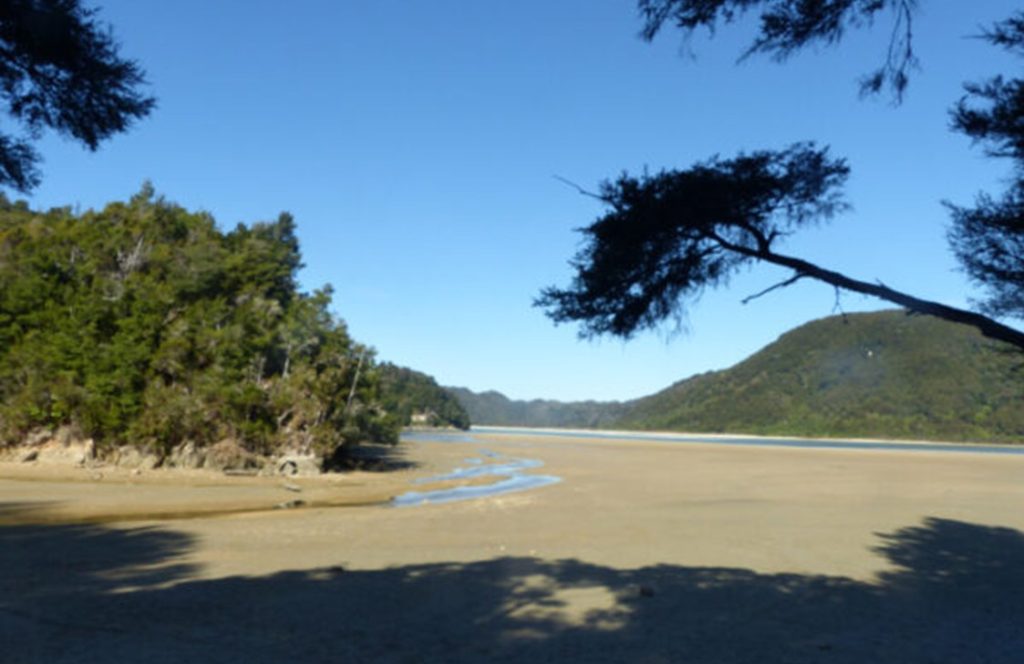
Wimping out is not an option. I start to count steps as I forge onward through water that millimeter by millimeter gets deeper. The other side is still very far away.
Garrick takes off his pack and holds it above his head. Seriously? Yes. The next part is deeper, a lot deeper.
We all hoist our packs over our heads and forge ahead. The water rises up to my thighs, then to my buttocks, my waist and halfway up my chest. We keep walking. I think of my camera in the pack. I’d not put it in the provided plastic liner. Would I really need to swim? The water keeps rising. Centimeters replace millimeters, and still dry land is far away. The water reaches my armpits.
Then, to my relief, the water starts to recede. We keep slogging step by step and the water falls steadily until finally we reach sand.
Here’s Julia after the walk; you can see how high the water got.

Garrick promises us that we need to walk just another ten minutes to the lodge. The fast-filling estuary stretches to our left; the bush to our right. My water shoes are packed with pebbles. I finally give up trying to coax the pebbles into shiatsu-like positions and pull off the shoes to walk barefoot over the sand.
Meadowbank Homestead: Comfort in the Wild
Champagne greets us on arrival. The lodge, a lovingly rebuilt 19th-century homestead, offers gourmet meals, private bathrooms, and comfy beds, all framed by estuary views that glow at sunset.
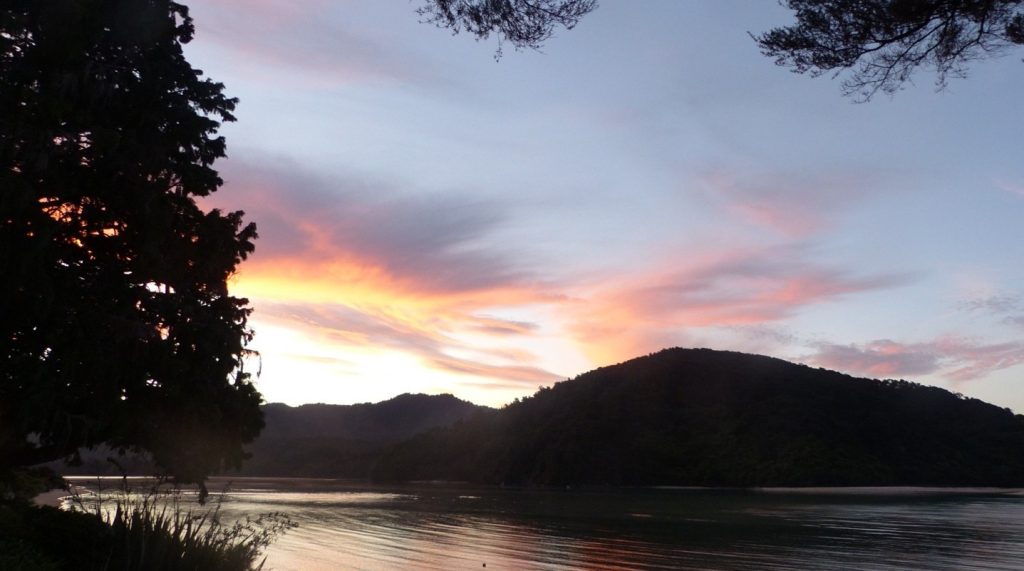
After downing a glass of chilled champagne, my next priority is a shower in the huge modern shower enclosure—too big to be called a stall. Few things in life feel more divine than hot water sluicing over a sand-encrusted body.
I change into dry clothes and join the group on the veranda where I quickly acquire a glass of Sauvignon Blanc. The sun floods the estuary with a flaming golden light, the water an iridescent turquoise.
Day 1 Dinner
Dinner consists of soya-soaked noodles with bright crunchy greens followed by rack of lamb accompanied by a spinach salad and barley risotto with Parmesan cheese. Dessert is cheese and crackers for me; cheesecake for Julia.
Every bite is excellent.
Coffee in the lounge is followed by a presentation about the family who settled this place. It really is a fascinating story that even includes a murder.
Day 2: Kayaking and Connection in Abel Tasman
Breakfast starts at 7:30 with granola and yogurt followed by a cooked option. I choose porridge served with real cream and brown sugar. Hot toast is delivered to the table by the hard-working guides.
Morning Walk
At 9 am, we start off on a morning walk to a bay where the kayaks await. Julia has a cold and decides to stay at the lodge. She will catch the coastal boat at noon, hang out on the beach for awhile, and then walk the final two-hour stretch with Garrick.
The first walk of the day takes us up gentle switchbacks to a spectacular lookout. I like gentle switchbacks. They require effort and sweat but not to an excessive degree.
From the top, the track heads back downhill to the ocean. Just before we arrive at our destination, a series of wooden bridges across the estuary provide a welcome diversion. It is all so incredibly scenic.
I arrive at the beach to find kayaks lounging like fat red and yellow crayons on the golden sand.
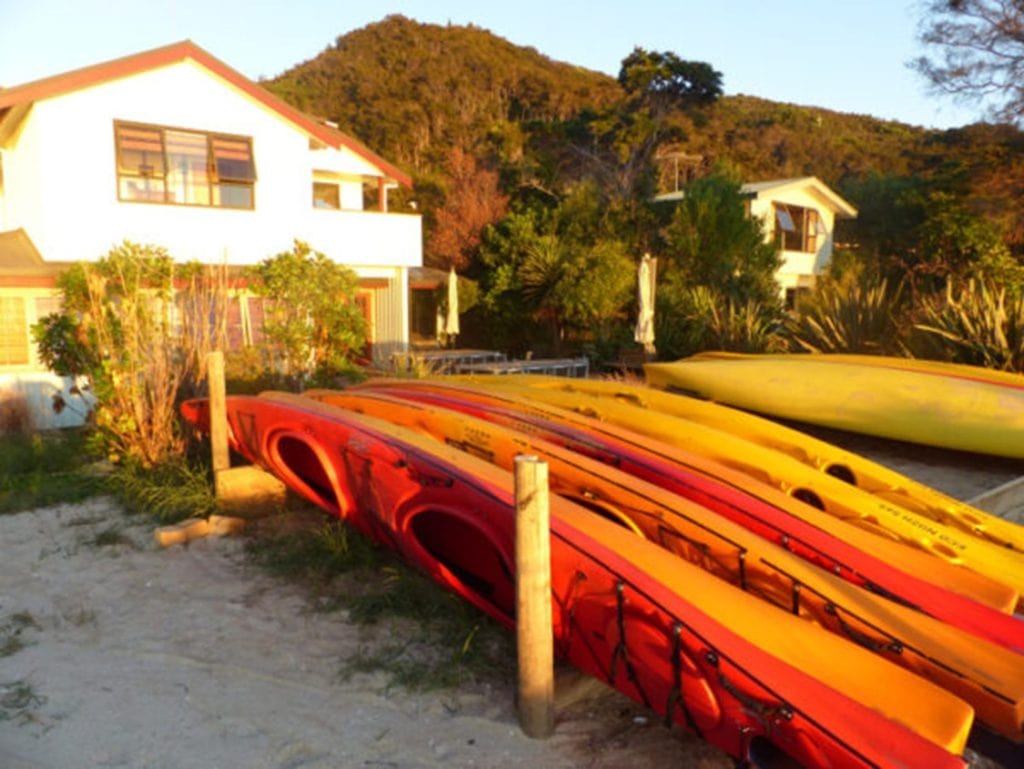
Kayak Safety
After being instructed in kayaking safety, we each squeeze into our skirts and life jackets, looking for all the world like a troupe of aging and demented ballerinas.
We learn how to get into the kayak, attach the spray skirt, work the pedals, and then get out of the kayak. We also learn about capsizing and are assured it will not happen. I hold on to that thought.
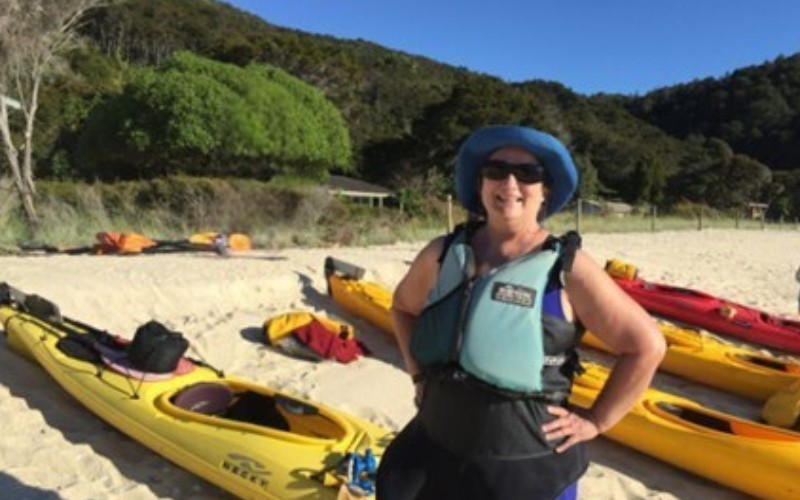


Out on the Water
Finally, we push the kayaks into the water and are seated for real. I’m paired with a Belgian speed demon who sets an Olympic trial pace. I find out later that he was a rower in his youth.
Within seconds, my arms are aching and I seriously question the wisdom and even the possibility of five more hours of paddling. Dip, twist, dip, twist, the pace he sets shoots us forward. Finally, Jack our kayak guide, yells at us to stop and wait for the rest of the group to catch up.
Fine with me. I have no need to be the fastest kayaker, although apparently my companion does.
Spectacular Kayaking in Abel Tasman National Park
We kayak at a slower pace across an azure sea past golden crescent beaches and around islands crusted with jumbled white rocks. Sea birds with skinny black necks cry into the wind, and the plump brown jelly beans basking on the rocks turn out to be seals.
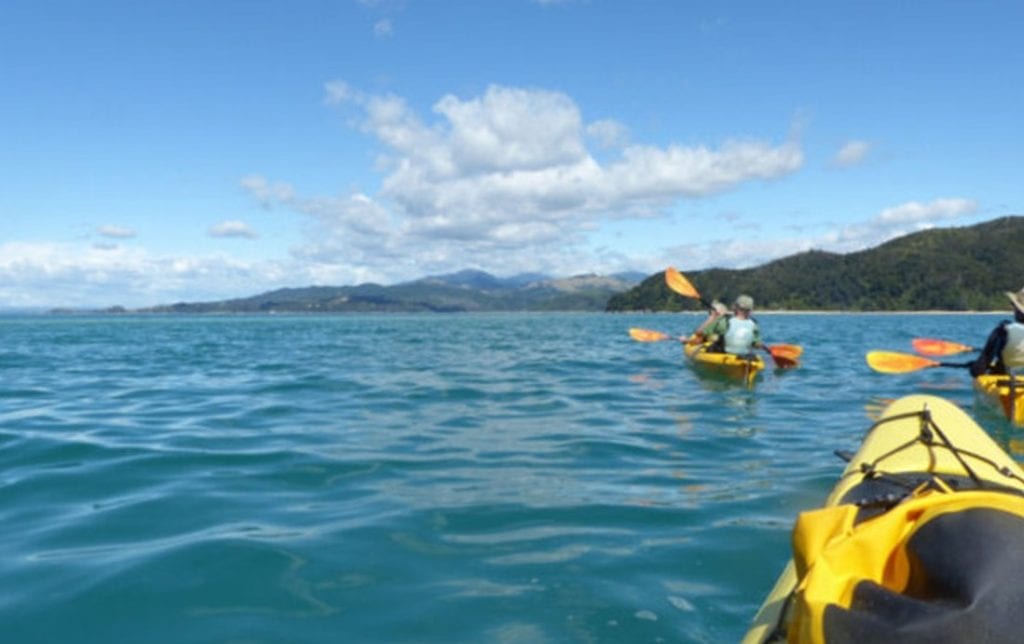
One of the seals rolls into the sea and swims towards us—waving his fins and doing somersaults.
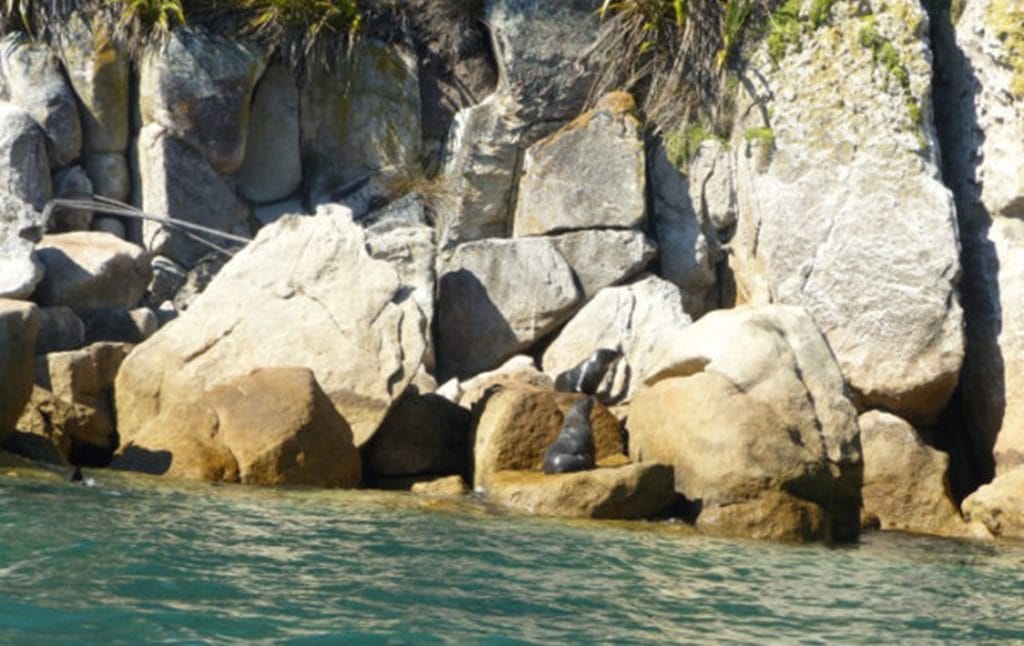
We’re not allowed to go closer to the seals than twenty meters but if the seals come to us to play, that is okay. We’re lucky to experience a full on seal encounter with a good five minutes of frolicking to remind us that life is joy.
Kayak Sailing
After paddling quietly around an island, we head out across a wide expanse of ocean heading south. Jack gets us to raft the kayaks together and tells us we are going to sail. The two women at the front of the two outside kayaks hold the bottom two corners of the square black sail. Straps from the top two corners are wrapped around two paddles held aloft by the two men in the two outside kayaks.
The sail is raised and we’re off. When I look at the land, I feel like we are not really moving, but when I look down at the wake rushing between my kayak and the one next to me, I see a considerable wake. We are sailing as fast, maybe a bit faster, then we can paddle but with a lot less effort.
Evening at Torrent Bay Lodge
At the end of a wonderful day of kayaking, we ground our kayaks on the sand in front of Torrent Bay Lodge. I make my grateful way to my room to find Julia is already there, showered and relaxed after a two-hour hike along the track.
After a hot shower, I change into my one dry outfit reserved for the evenings and join the rest of the group out on another picturesque veranda overlooking the ocean and a soft pastel sunset.
Dinner is perfectly cooked salmon, cheesy potatoes, and salad followed by key lime pie. I try to stay up as long as possible, but by 9:30 pm, my eyes no longer keep open.
We turn off the light and drop into the heavy sleep of the well-exercised.
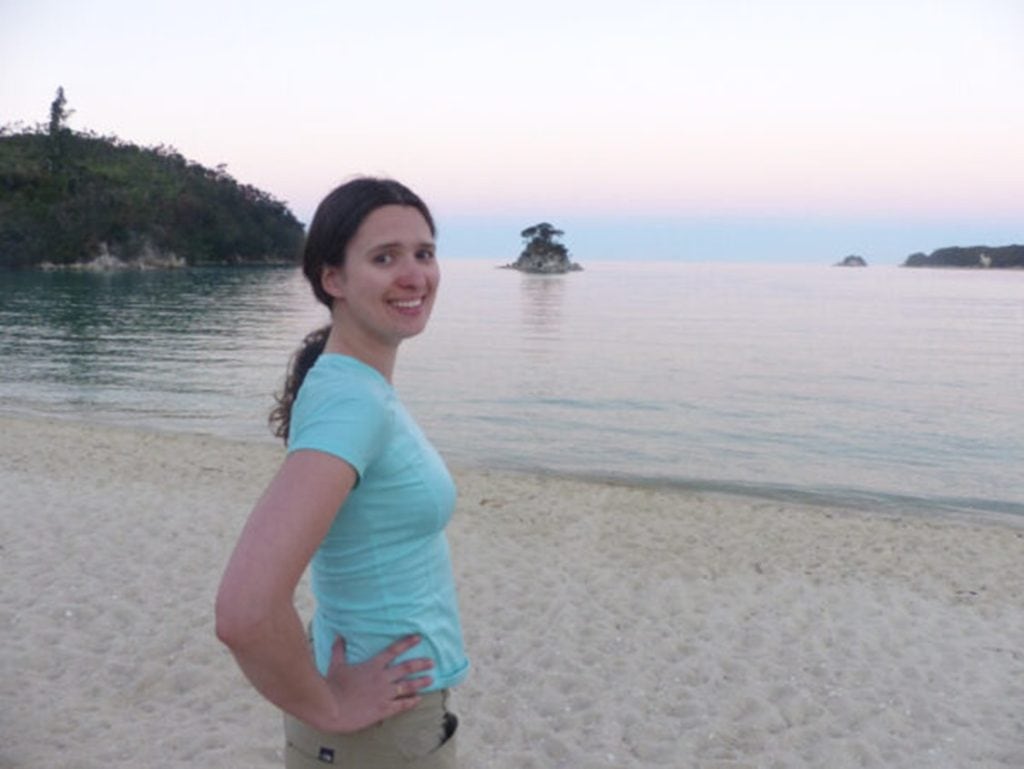
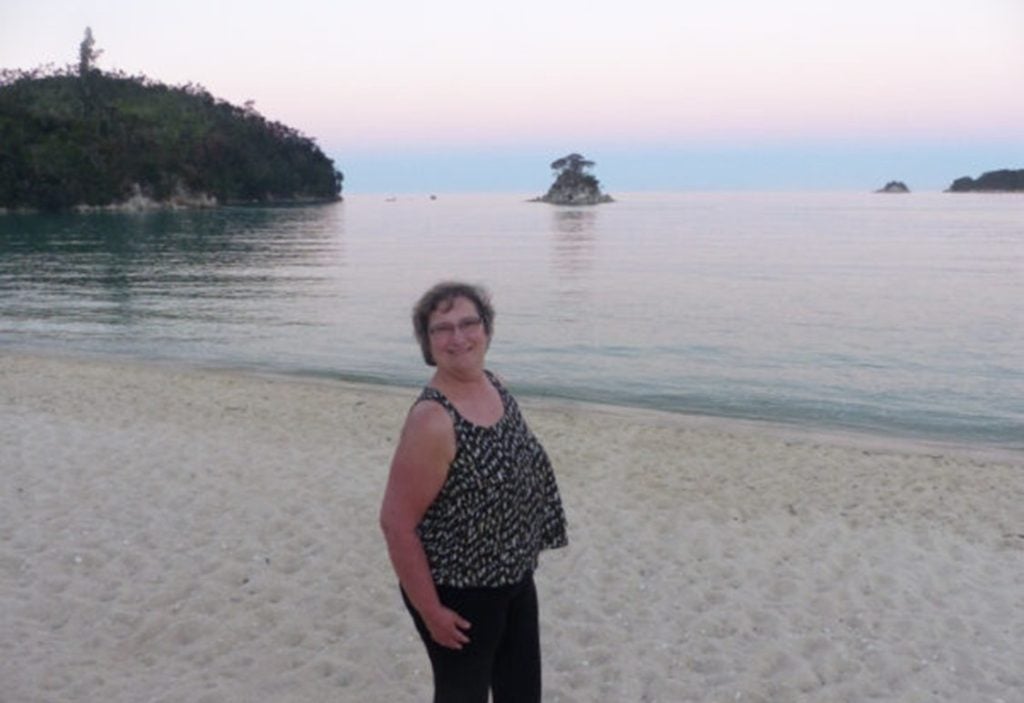
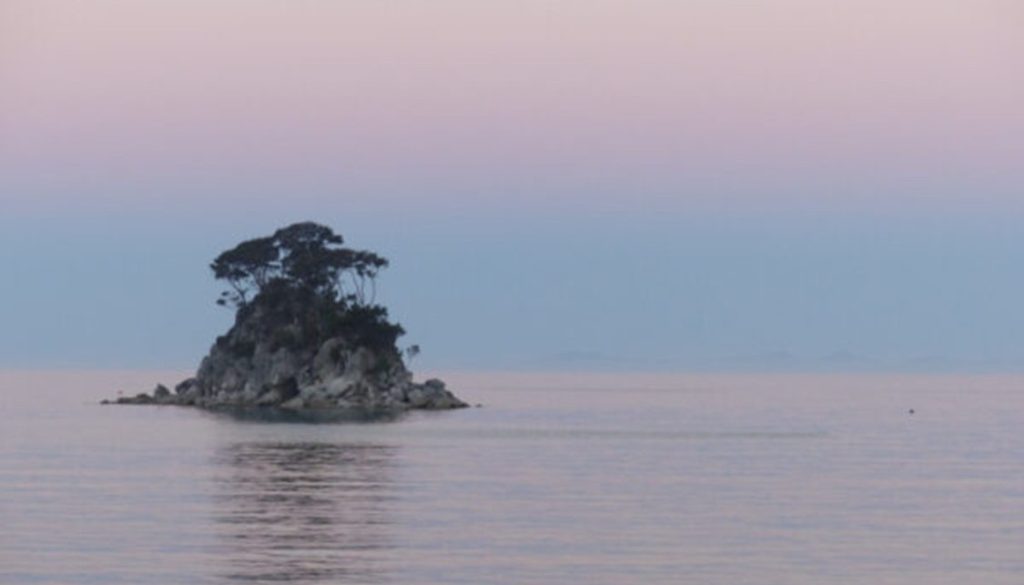
Day 3: Farewell to the Golden Coast
Dawn rises over the Tasman Sea the next morning as we enjoy a breakfast of zucchini fritters, bacon, and assorted breads, juices, and coffee or tea. The food really is first rate.
On this the last day of the three-day trip, I kayak for the morning and then walk for the afternoon. Julia again takes the boat to the lunch spot while I kayak. We’ll walk together in the afternoon.
Kayaking with Jack
On the second day of kayaking, I am fortunately paired with Jack, the guide. The Belgian speed freak has left early and I can comfortably enjoy a much less frenetic experience. My right arm is very sore after day one and so I often need to rest it.
Fortunately, for much of the morning, we drift slowly past seal-crusted rocks ringing an island that has been made into a bird sanctuary. The cacophony of bird sounds is lovely to hear, but apparently it’s only a whisper compared to how the birds sounded back when Captain Cook arrived in the 1700s.
The bird song that had shattered the dawn at four in the morning every day was so loud that Cook had been obliged to move his ships farther out to sea so his crew could get their beauty sleep.
Lunch on the Beach
After our morning of kayaking, we meet Julia on the beach and enjoy our packed lunch. The company has seen to every detail. On both mornings, the group can pack their own lunches from an assortment of food laid out on the back porch of the lodges.
Along with plenty of healthy choices are a few bins of candy—jelly beans, fudge, licorice. What’s not to love?
Last Walk Along the Track
Our last afternoon is spent walking the final portion of track before we reach the beginning of the park where we’d caught the boat two days earlier.
Garrick sets a leisurely pace along a track fortunately devoid of any steep bits. The scenery on this last day is as spectacular as ever.
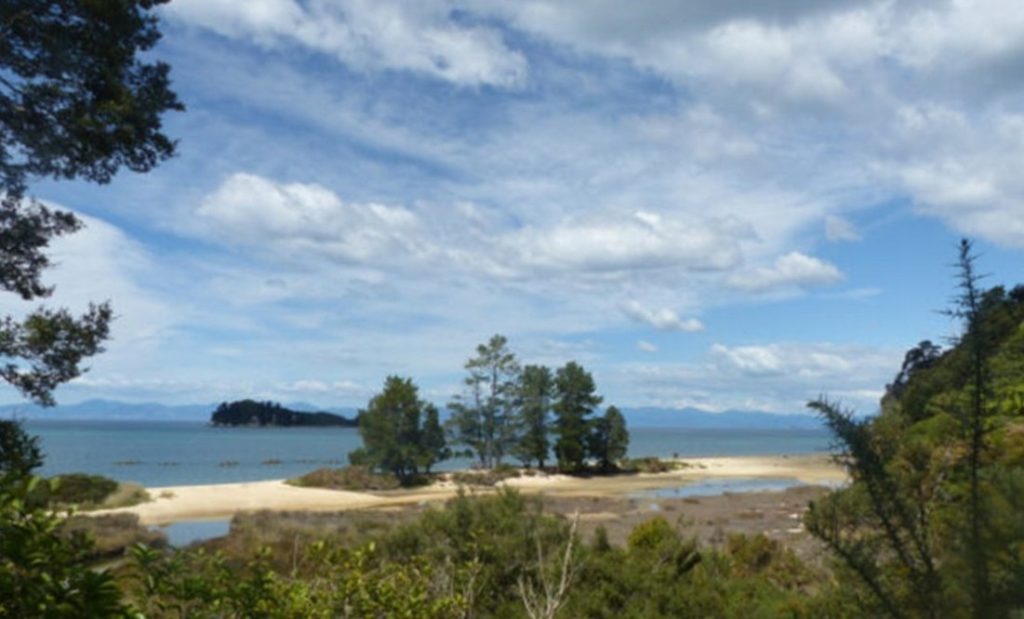
A Wilsons bus picks us up (they really have their infrastructure organized well) and delivers us back at the office in Motueka where I settle my bar bill for the two nights and then board a minibus for the trip back to our hotel in Nelson.
The three days have been perfect in every way.
Reflections
The Abel Tasman Kayak & Walk with Wilsons Abel Tasman isn’t just a trip — it’s a love letter to nature, a reminder of balance, and an invitation to slow down.
I can’t recommend it highly enough. Here are some more tour options in Abel Tasman National Park from GetYourGuide:
More About New Zealand
Here are all the posts I wrote to document my three-week driving trip around New Zealand. Check out my tips and recommendations for exploring this magical country.
- 10 Awesome Things to Do in Queenstown, New Zealand
- Driving the West Coast of New Zealand’s South Island
- Abel Tasman National Park: Best Luxury Adventure
- Best of Wellington in One Day: Culture & Charm
- What to See in New Zealand’s Steamy North Island
- Discover New Zealand’s North Island: Hobbiton, the Coromandel, & Auckland
Have you visited New Zealand? Share your suggestions for other Artsy Travelers in the Comments below.
